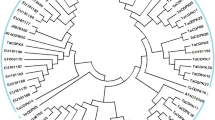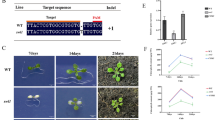Abstract
Background and aims
Nitrate reductase (NR) is highly conserved among plants and has an important role in plant nitrate assimilation pathway. Previous studies show that NR is regulated by circadian clock. However, the molecular mechanism remained elusive. In this study, we tried to find the central circadian clock component which is involved in transcriptional regulation of NR genes, NIA1 and NIA2 in Arabidopsis thaliana.
Methods
Electrophoresis mobility shift assay (EMSA) was used to test whether recombinant CCA1 protein could directly bind to a fragment of NIA1 and NIA2 promoter and whether the binding requires CCA1 binding site (CBS). Real-time quantitative RT-PCR was used to examine the mRNA expression of NIA1 and NIA2 in CCA1 loss of function mutant (cca1–1) plants contrast with wild type.
Results
CBSs were found in both upstream regions of NIA1 and NIA2. EMSA assay confirmed that CCA1 associates with the separate upstream regions of NIA1 or NIA2 in vitro. NIA1 and NIA2 expression analysis in cca1–1 plants showed that NIA1 is activated by CCA1 while NIA2 is repressed by CCA1.
Conclusions
In summary, our current data provide some molecular evidences that circadian regulation of NIA1 and NIA2 involves action of CCA1 protein binding to the promoters of these genes and regulating their transcription.




Similar content being viewed by others
Abbreviations
- N:
-
Nitrogen
- NR:
-
Nitrate reductase
- CAB:
-
Chlorophyll a/b-binding protein
- CBS:
-
CCA1 binding sites
- EMSA:
-
Electrophoresis mobility shift assay
- GST:
-
Glutathione S-transferase
- WT:
-
Wild-type
- WS :
-
Wassilewskija
References
Alabadi D, Oyama T, Yanovsky MJ, Harmon FG, Mas P, Kay SA (2001) Reciprocal regulation between TOC1 and LHY/CCA1 within the Arabidopsis circadian clock. Science 293:880–883
Alabadí D, Yanovsky MJ, Más P, Harmer SL, Kay SA (2002) Critical role for CCA1 and LHY in maintaining circadian rhythmicity in Arabidopsis. Curr Biol 12:757–761
Andronis C, Barak S, Knowles SM, Sugano S, Tobin EM (2008) The clock protein CCA1 and the bZIP transcription factor HY5 physically interact to regulate gene expression in Arabidopsis. Mol Plant 1(1):58–67
Cheng CL, Acedo GN, Dewdney J, Goodman HM, Conlking MA (1991) Differential expression of the two Arabidopsis nitrate reductase genes. Plant Physiol 96:275–279
Cohen AS, Cumming BG (1974) Endogenous rhythmic activity of nitrate reductase in a selection of Chenopodium rubrum. Can J Bot 52:2351–2360
Cookson SJ, Williams LE, Miller AJ (2005) Light-dark changes in cytosolic nitrate pools depend on nitrate reductase activity in Arabidopsis leaf cells. Plant Physiol 138:1097–1105
Deng MD, Moureaux T, Cherel I, Boutin J-P, Caboche M (1991) Effects of nitrogen metabolites on the regulation and circadian expression of tobacco nitrate reductase. Plant Physiol Biochem 29:239–247
Farre EM, Harmer SL, Harmon FG, Yanovsky MJ, Kay SA (2005) SA overlapping and distinct roles of PRR7 and PRR9 in the Arabidopsis circadian clock. Curr Biol 15:47–54
Freschi L, Nievola CC, Rodrigues MA, Domingues DS, Van Sluys MA, Mercier H (2009) Thermoperiod affects the diurnal cycle of nitrate reductase expression and activity in pineapple plants by modulating the endogenous levels of cytokinins. Physiol Plant 137:201–212
Galangau F, Daniel-Vedele F, Moureaux T, Dorbe MF, Leydecker MT, Caboche M (1988) Expression of leaf nitrate reductase genes from tomato and tobacco in relation to light-dark regimes and nitrate supply. Plant Physiol 88:383–388
Goodstein DM, Shu S, Howson R, Neupane R, Hayes RD, Fazo J et al (2012) Phytozome: a comparative platform for green plant genomics. Nucleic Acids Res 40:1178–1186
Grundy J, Stoker C, Carré IA (2015) Circadian regulation of abiotic stress tolerance in plants. Front Plant Sci 6:648. doi:10.3389/fpls.00648
Gutiérrez RA, Stokes TL, Thum K, Xu X, Obertello M, Katari MS, Tanurdzic M, Dean A, Nero DC, CR MC, Coruzzi GM (2008) Systems approach identifies an organic nitrogen-responsive gene network that is regulated by the master clock control gene CCA1. Proc Natl Acad Sci U S A 105:4939–4944
Hao F, Zhao S, Dong H, Zhang H, Sun L, Miao C (2010) Nia1 and Nia2 are involved in exogenous salicylic acid-induced nitric oxide generation and stomatal closure in Arabidopsis. J Integr Plant Biol 52(3):298–307
Harmer SL (2009) The circadian system in higher plants. Annu Rev Plant Biol 60:357–377
Harmer SL, Hogenesch JB, Straume M, Chang HS, Han B, Zhu T, Wang X, Kreps JA, Kay SA (2000) Orchestrated transcription of key pathways in Arabidopsis by the circadian clock. Science 290:2110–2113
Haydon MJ, Román Á, Arshad W (2015) Nutrient homeostasis within the plant circadian network. Front Plant Sci 6:299. doi:10.3389/fpls.2015.00299
Hazen SP, Schultz TF, Pruneda-Paz JL, Borevitz JO, Ecker JR, Kay SA (2005) LUX ARRHYTHMO encodes a Myb domain protein essential for circadian rhythms. Proc Natl Acad Sci U S A 102:10387–10392
Hoff T, Truong HN, Caboche M (1994) The use of mutants and transgenic plants to study nitrate assimilation. Plant Cell Environ 17:489–506
Jonassen EM, Sandsmark BAA, Lillo C (2009) Unique status of NIA2 in nitrate assimilation: NIA2 expression is promoted by HY5/HYH and inhibited by PIF4. Plant Signal Behav 4:1084–1086
Jones TL, Tucker DE, Ort DR (1998) Chilling delays circadian pattern of sucrose phosphate synthase and nitrate reductase activity in tomato. Plant Physiol 118:149–158
Kawamura M, Ito S, Nakamichi N, Yamashino T, Mizuno T (2008) The function of the clock-associated transcriptional regulator CCA1 (CIRCADIAN CLOCK-ASSOCIATED 1) in Arabidopsis thaliana. Biosci Biotechnol Biochem 72(5):1307–1316
Kenigsbuch D, Tobin EM (1995) A region of the Arabidopsis Lhcb1 3 promoter that binds to CA-1activity is essential for high expression and phytochrome regulation. Plant Physiol 108:1023–1027
Konishi M, Yanagisawa S (2013) Arabidopsis NIN-like transcription factors have a central role in nitrate signaling. Nat Commun 4:1617. doi:10.1038/ncomms2621
Li G, Siddiqui H, Teng Y, Lin R, Wan XY, Li J, Lau OS, Ouyang X, Dai M, Wan J, Devlin PF, Deng XW, Wang H (2011) Coordinated transcriptional regulation underlying the circadian clock in Arabidopsis. Nat Cell Biol 13:616–622
Lillo C (1984) Circadian rhythmicity of nitrate reductase activity in barley leaves. Physiol Plant 61:219–223
Lillo C (1991) Diurnal variations of corn leaf nitrate reductase: an experimental distinction between transcriptional and posttranscriptional control. Plant Sci 73:149–154
Lyons LC, Darlington TK, Hao H, Houl J, Kay SA, Hardin PE (2000) Specific sequences outside the E-box are required for proper per expression and behavioral rescue. J Biol Rhythm 15:472–482
Matsushika A, Makino S, Kojima M, Mizuno T (2000) Circadian waves of expression of the APRR1/TOC1 family of pseudo-response regulators in Arabidopsis thaliana: insight into the plant circadian clock. Plant Cell Physiol 41:1002–1012
Michael TP, McClung CR (2002) Phase-specific circadian clock regulatory elements in Arabidopsis. Plant Physiol 130:627–638
Mizoguchi T, Wheatley K, Hanzawa Y, Wright L, Mizoguchi M, Song HR, Carré IA, Coupland G (2002) LHY and CCA1 are partially redundant genes required to maintain circadian rhythms in Arabidopsis. Dev Cell 2:629–641
Mu XJ, Lu ZJ, Kong Y, Lam HYK, Gerstein MB (2011) Analysis of genomic variation in non-coding elements using population-scale sequencing data from the 1000 genomes project. Nucleic Acids Res 39:7058–7076
Munoz E, Brewer M, Baler R (2002) Circadian transcription: thinking outside the E-box. J Biol Chem 277:36009–36017
Pilgrim ML, Caspar T, Quail PH, McClung CR (1993) Circadian and light-regulated expression of nitrate reductase in Arabidopsis. Plant Mol Biol 23:349–364
Pruneda-Paz JL, Kay SA (2010) An expanding universe of circadian networks in higher plants. Trends Plant Sci 15:259–265
Schaffer R, Ramsay N, Samach A, Corden S, Putterill J, Carré IA, Coupland G (1998) The late elongated hypocotyl mutation of Arabidopsis disrupts circadian rhythms and the photoperiodic control of flowering. Cell 93:1219–1229
Sharma M, Bhatt D (2015) The circadian clock and defence signalling in plants. Mol Plant Pathol 16(2):210–218
Sivasankar S, Oaks A (1996) Nitrate assimilation in higher plants: the effect of metabolites and light. Plant Physiol Bioch 34:609–620
Stitt M (1999) Nitrate regulation of metabolism and growth. Curr Opin Plant Biol 2:178–186
Sun L, Doxsee RA, Harel E, Tobin EM (1993) CA-1, a novel phosphoprotein, interacts with the promoter of the cab140 gene in Arabidopsis and is undetectable in det1 mutant seedlings. Plant Cell 5:109–121
Tucker DE, Allen DJ, Ort DR (2004) Control of nitrate reductase by circadian and diurnal rhythms in tomato. Planta 219:277–285
Wang ZY, Tobin EM (1998) Constitutive expression of the CIRCADIAN CLOCK ASSOCIATED 1 (CCA1) gene disrupts circadian rhythms and suppresses its own expression. Cell 93:1207–1217
Wang ZY, Kenigsbuch D, Sun L, Harel E, Ong MS, Tobin EM (1997) A Myb-related transcription factor is involved in the phytochrome regulation of an Arabidopsis Lhcb gene. Plant Cell 9:491–507
Wang G, Zhang C, Battle S, Lu H (2014) The phosphate transporter PHT4;1 is a salicylic acid regulator likely controlled by the circadian clock protein CCA1. Front Plant Sci 5:701. doi:10.3389/fpls.2014.00701
Wilkinson JQ, Crawford NM (1993) Identification and characterization of a chlorate-resistant mutant of Arabidopsis thaliana with mutations in both nitrate reductase structural genes NIA1 and NIA2. Mol Gen Genet 239:289–297
Yanagisawa S (2014) Transcription factors involved in controlling the expression of nitrate reductase genes in higher plants. Plant Sci 229:167–171
Yu XD, Sukumaran S, Marton L (1998) Differential expression of the Arabidopsis NIA1 and NIA2 genes. Plant Physiol 116:1091–1096
Acknowledgements
This work was supported by grants from the National Science Foundation of China (No. 31200190, 31400229), and Department of Education of Zhejiang Province (No. Y200909815).
Author information
Authors and Affiliations
Corresponding author
Additional information
Responsible Editor: Ad C. Borstlap.
Rights and permissions
About this article
Cite this article
Teng, Y., Cui, H., Wang, M. et al. Nitrate reductase is regulated by CIRCADIAN CLOCK-ASSOCIATED1 in Arabidopsis thaliana . Plant Soil 416, 477–485 (2017). https://doi.org/10.1007/s11104-017-3208-y
Received:
Accepted:
Published:
Issue Date:
DOI: https://doi.org/10.1007/s11104-017-3208-y




